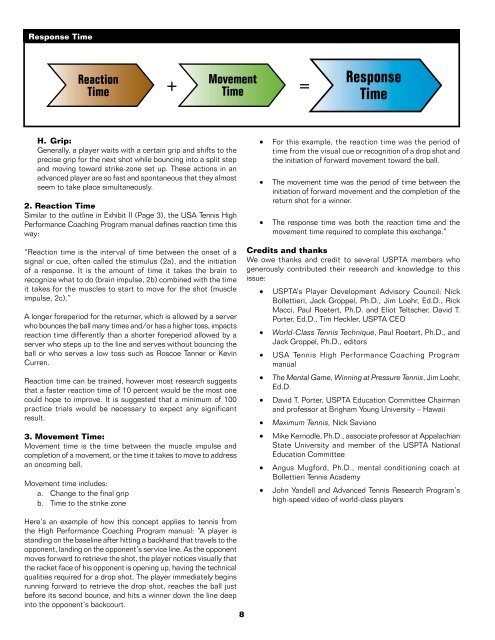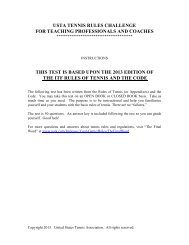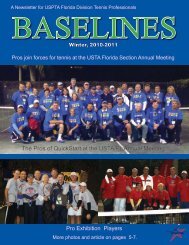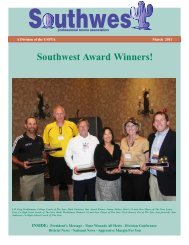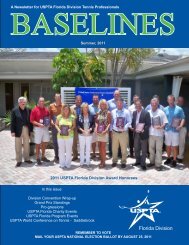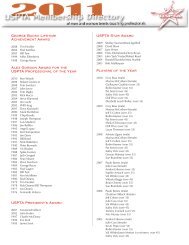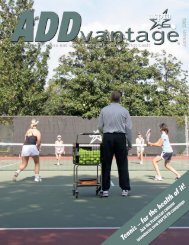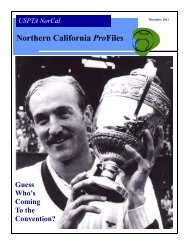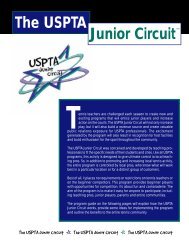Volume 2, No. 3 - United States Professional Tennis Association
Volume 2, No. 3 - United States Professional Tennis Association
Volume 2, No. 3 - United States Professional Tennis Association
You also want an ePaper? Increase the reach of your titles
YUMPU automatically turns print PDFs into web optimized ePapers that Google loves.
Response Time<br />
Reaction<br />
Time<br />
Movement<br />
+ Time =<br />
Response<br />
Time<br />
H. Grip:<br />
Generally, a player waits with a certain grip and shifts to the<br />
precise grip for the next shot while bouncing into a split step<br />
and moving toward strike-zone set up. These actions in an<br />
advanced player are so fast and spontaneous that they almost<br />
seem to take place simultaneously.<br />
2. Reaction Time<br />
Similar to the outline in Exhibit II (Page 3), the USA <strong>Tennis</strong> High<br />
Performance Coaching Program manual defines reaction time this<br />
way:<br />
“Reaction time is the interval of time between the onset of a<br />
signal or cue, often called the stimulus (2a), and the initiation<br />
of a response. It is the amount of time it takes the brain to<br />
recognize what to do (brain impulse, 2b) combined with the time<br />
it takes for the muscles to start to move for the shot (muscle<br />
impulse, 2c).”<br />
A longer foreperiod for the returner, which is allowed by a server<br />
who bounces the ball many times and/or has a higher toss, impacts<br />
reaction time differently than a shorter foreperiod allowed by a<br />
server who steps up to the line and serves without bouncing the<br />
ball or who serves a low toss such as Roscoe Tanner or Kevin<br />
Curren.<br />
Reaction time can be trained, however most research suggests<br />
that a faster reaction time of 10 percent would be the most one<br />
could hope to improve. It is suggested that a minimum of 100<br />
practice trials would be necessary to expect any significant<br />
result.<br />
3. Movement Time:<br />
Movement time is the time between the muscle impulse and<br />
completion of a movement, or the time it takes to move to address<br />
an oncoming ball.<br />
Movement time includes:<br />
a. Change to the final grip<br />
b. Time to the strike zone<br />
· For this example, the reaction time was the period of<br />
time from the visual cue or recognition of a drop shot and<br />
the initiation of forward movement toward the ball.<br />
· The movement time was the period of time between the<br />
initiation of forward movement and the completion of the<br />
return shot for a winner.<br />
· The response time was both the reaction time and the<br />
movement time required to complete this exchange.”<br />
Credits and thanks<br />
We owe thanks and credit to several USPTA members who<br />
generously contributed their research and knowledge to this<br />
issue:<br />
· USPTA’s Player Development Advisory Council: Nick<br />
Bollettieri, Jack Groppel, Ph.D., Jim Loehr, Ed.D., Rick<br />
Macci, Paul Roetert, Ph.D. and Eliot Teltscher, David T.<br />
Porter, Ed.D., Tim Heckler, USPTA CEO<br />
· World-Class <strong>Tennis</strong> Technique, Paul Roetert, Ph.D., and<br />
Jack Groppel, Ph.D., editors<br />
· USA <strong>Tennis</strong> High Performance Coaching Program<br />
manual<br />
· The Mental Game, Winning at Pressure <strong>Tennis</strong>, Jim Loehr,<br />
Ed.D.<br />
· David T. Porter, USPTA Education Committee Chairman<br />
and professor at Brigham Young University – Hawaii<br />
· Maximum <strong>Tennis</strong>, Nick Saviano<br />
· Mike Kernodle, Ph.D., associate professor at Appalachian<br />
State University and member of the USPTA National<br />
Education Committee<br />
· Angus Mugford, Ph.D., mental conditioning coach at<br />
Bollettieri <strong>Tennis</strong> Academy<br />
· John Yandell and Advanced <strong>Tennis</strong> Research Program’s<br />
high-speed video of world-class players<br />
Here’s an example of how this concept applies to tennis from<br />
the High Performance Coaching Program manual: “A player is<br />
standing on the baseline after hitting a backhand that travels to the<br />
opponent, landing on the opponent’s service line. As the opponent<br />
moves forward to retrieve the shot, the player notices visually that<br />
the racket face of his opponent is opening up, having the technical<br />
qualities required for a drop shot. The player immediately begins<br />
running forward to retrieve the drop shot, reaches the ball just<br />
before its second bounce, and hits a winner down the line deep<br />
into the opponent’s backcourt.<br />
8


